 Suborder Serpentes (Snakes)
Suborder Serpentes (Snakes)
Family Typhlopidae (Blind or Worm Snakes)
These snakes are found throughout the world and in most parts of Australia. They are often called Worm Snakes because of their worm-like appearance. All are pinkish or brown in colour, and covered in smooth shiny scales. They are also called Blind Snakes because their eyes are reduced to small spots, which give them nominal eyesight. They lack a distinct head and the tail (which is the same thickness as the body) terminates in a blunt spine that aids in progression.
Because of their secretive nature little is known about most types of Blind Snakes and they are without doubt the least known of Australia's snakes. About thirty species are currently recognised in Australia but the means of defining some of them have been dubious, to say the least.
Blind Snakes have traditionally been identified by variations in the cleft present on the nasal scale (which is now known to vary significantly within a single species), body scale counts and general morphology. However, the identification of given species remains difficult because so little is known about most species.
Blind Snakes are for a number of reasons regarded as being separate from all other snakes, and some scientists have placed them somewhere between lizards and snakes. A lizard-like characteristic of Blind Snakes is that their belly scales (ventrals) are a similar size to their dorsal scales, while other snakes have their characteristic broad belly (ventral) scales. Furthermore, Blind Snakes appear to be unable to swallow large prey items by dislocating their jaws in the normal snake-like manner.
Blind Snakes are mainly burrowers, only moving about on the ground surface on warm and/or wet nights. When caught most Blind Snakes release a pungent smell from well-developed anal glands. This smell serves the dual purposes of defence and attracting the opposite sex during the mating season.
Blind Snakes have ventrally positioned shark-like mouths, and are believed to feed on ants and termites. They are the only Australian snakes known to be insectivorous. They are unable to bite humans and lack venom glands.
They are all thought to be egg-layers.
The above was from the book Australian Reptiles and Frogs by Raymond Hoser and now available on a fantastic CD-Rom along with a vast amount of other information, papers and the like on reptiles, frogs and other wildlife.